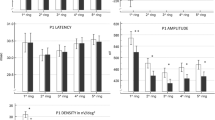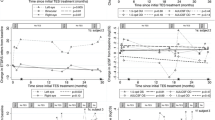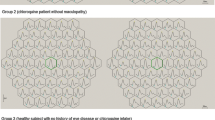Abstract
The purpose of this study to assess the effect of the formula taurine/diltiazem/vitamin E on the progression of visual field loss in retinitis pigmentosa. A double blind, placebo controlled study in 62 patients: visual field threshold values were obtained in a Humphrey Field Analyzer from center (30°) and periphery (30–60°), every 4 months during 3-year follow-up. Data were analyzed by univariate regression, with slopes obtained from the best fit lines. Based on slope values, three groups of patients were identified as those showing negative, positive, or zero slope: ≥-1 to ≤ + 1. In controls (32 patients), at central area, the distribution in negative, zero, or positive slope was, respectively, 16 (50%),11 (35%), and 5 (15%). In the treated group (30 patients) this distribution was 6 (20%) negative, 17 (53%) zero, and 7 (23%) positive slope. In periphery, 16 control patients were distributed as 11 (69%) negative, 4 (25%) zero, and 1 (6%) positive slope. In the treated group (17 patients), the distribution was opposite: 1 (6%) negative, 7 (41%) zero, and 9 (53%) positive slope. Nineteen patients receiving treatment up to 6 years showed similar distribution by slope values. Eight out of 9 patients switched from placebo (2 years) to treatment (2–3 years), showed improving changes in their slope values. A beneficial effect of the treatment decreasing the rate of visual field loss was observed, likely through a protective action from free radical reactions in affected photoreceptors.
Similar content being viewed by others
REFERENCES
Al-Dohayan, A.D., and Al-Tuwaijri, A.S. (1996). The potential synergistic effect of calcium channel blockers and alpha-tocopherol on gastric mucosal injury induced by ischaemia-reperfusion. Eur. J. Gastroenterol. Hepatol. 8:1107-1110.
Aonuma, H., Koide, K., Masuda, K., and Watanabe, I. (1997). Retinal light damage: Protective effect of alphatocopherol. Jpn. J. Ophthalmol. 41:160-167.
Baumgartner, W.A. (2000). Etiology, pathogenesis, and experimental treatment of retinitis pigmentosa. Med. Hyptheses 54:814-824.
Berson, E.L., Rosner, B., Sandberg, M.A., Hayes, K.C., Nicholson, B.W., Weigel-DiFranco, C., and Willet, W.l. (1993). A randomized trial of vitamin A and vitamin E supplementation for retinitis pigmentosa. Arch. Ophthalmol. 111:761-772.
Berson, E.L., Sandberg, M.A., Rosner, B., Birch, D.G., and Hanson, A.H. (1985). Natural course of retinitis pigmentosa over a three-year interval. Am. J. Ophthalmol. 99:240-251.
Bhattacharya, R., and Rao, P.V.L. (1997). Cyanide induced DNA fragmentation in mammalian cell cultures. Toxicology 123:207-215.
Boughman, J.A., Coneally, M., and Nance, W.E. (1980). Population genetic studies of retinitis pigmentosa. Am. J. Hum. Genet. 32:223-235.
Bush, R.A., Kononen, L., Machida, S., and Sieving, P.A. (2000). The effect of calcium channel blocker diltiazem on photoreceptor degeneration in the rhodopsin Pro213His rat. Invest. Ophthalmol. Vis. Sci. 9:2697-2701.
Carmody, R.J., McGowan, A.J., and Cotter, T.G. (1999). Reactive oxygen species as mediators of photoreceptor apoptosis in vitro. Exp. Cell Res. 248:520-530.
Communal, C., Singh, K., Pimentel, D.R., and Colucci,W.S. (1998). Norepinephrine stimulates apoptosis in adult rat ventricular myocytes by activation of the beta-adrenergic pathway. Circulation 98:1329-1334.
El Idrissi, A., and Trenkner, E. (1999). Growth factors and taurine protect against excitotoxicity by stabilizing calcium homeostasis and energy metabolism. J. Neurosci. 19:9459-9468.
Frasson, M., Sahel, J.A., Fapre, M., Simmonuti, M., Dreyfus, H., and Picaud, S. (1999). Retinitis pigmentosa: Rod photoreceptor rescue by a calcium-channel blocker in the rd mouse. Nat. Med. 5:1183-1187.
Grover, S., Fishman, G.A., Anderson, R.J., Alexander, K.R., and Derlacki, D.J. (1997). Rate of visual field loss in retinitis pigmentosa. Ophthalmology 104:460-465.
Hayes, K., Carey, R., and Schmidt, S. (1975). Retinal degeneration associated with taurine deficiency in the cat. Science 188:945-951.
Heckenlively, J.R. (1988). Retinitis Pigmentosa, Lippincott, Philadelphia, Pennsylvania.
Holopigian, K., Greenstein, V., Seiple,W., and Carr, R.E. (1996). Rates of change differ among measures of visual function in patients with retinitis pigmentosa. Ophthalmology 103:398-405.
Humphries, P., Kenna, P., and Farrar, G.J. (1992). On the molecular genetics of retinitis pigmentosa. Science 256:804-808.
Huxtable, R.J. (1992). The physiological actions of taurine. Physiol. Rev. 72:101-173.
Keys, S.A., and Zimmerman, W.F. (1999). Antioxidant activity of retinol, glutathione and taurine in bovine photoreceptor membranes. Exp. Eye Res. 68:693-702.
Marchiafava, P.L., and Longoni, B. (1999). Melatonin as an antioxidant in retinal photoreceptors. J. Pineal Res. 26:184-189.
Massof, R.W., and Finkelstein, D. (1987). A two-stage hypothesis for the natural course of retinitis pigmentosa. Adv. Biosci. 52:29-58.
Newsome, D.A., Micele, M.V., Liles, M.R., Tate, D., and Oliver, P.D. (1991). Antioxidants in the retinal pigment epithelium. Prog. Retinal Eye Res. 13:101-122.
Pagon, R.A. (1988). Retinitis pigmentosa. Surv. Ophthalmol. 33:137-177.
Pasantes-Morales, H., Ademe, R.M., and Quesada, O. (1981). Protective effect of taurine on the light-induced disruption of isolated frog rod outer segments. J. Neurosci. Res. 6:337-348.
Pasantes-Morales, H., and Cruz, C. (1984). Protective effect of taurine and zinc on peroxidation-induced damage in photoreceptor outer segments. J. Neurosci. Res. 11:303-311.
Pasantes-Morales, H., Lopez-Escalera, R., and Diaz-Macedo,M.(1988). Taurine and ionic fluxes in photoreceptors. Neurol. Neurobiol. 49:87-104.
Pasantes-Morales, H., Wright, C.E., and Gaull, G.E. (1985). Taurine protection of lymphoblastoid cells from iron-ascorbate induced damage. Biochem. Pharmacol. 34:205-207.
Pearce-Kelling, S.E., Aleman, T.S., Nickle, A., Laties, A.M., Aguirre, G.D., Jacobson, S.G., and Acland, G.M. (2001). Calcium channel blocker D-cis-diltiazem does not slow retinal degeneration in the PDE6B mutant rcd1 canine model of retinitis pigmentosa. Mol. Vis. 7:42-47.
Robison, W.G., Kuwabara, T., and Bieri, J.G. (1979). Vitamin E deficiency and the retina: Photoreceptor and pigment epithelial changes. Invest. Ophthalmol. Vis. Sci. 18:683-690.
Schurr, A., Payne, R.S., and Rigor, B.M. (1995a). Synergism between diltiazem and MK-801 but not APV in protecting hippocampal slices against hypoxic damage. Brain Res. 685:233-236.
Schurr, A., Payne, R.S., and Rigor, B.M. (1995b). Protection by MK-801 against hypoxia-, excitotoxin-, and depolarization-induced neuronal damage in vitro. Neurochem. Int. 26:19-25.
Tarif, N., and Bakris, G.L. (1997). Preservation of renal function: The spectrum of effects by calcium-channel blockers. Nephrol. Dial. Transplant. 12:2244-2250.
van Soest, S., Westerveld, A., de Jong, P.T., Bleeker-Wagemakers, E.M., and Bergen, A.A. (1999). Retinitis pigmentosa: Defined from a molecular point of view. Surv. Ophthalmol. 43:321-334.
Wong, F. (1997). Investigating retinitis pigmentosa: A laboratory scientist's perspective. Prog. Retinal Eye Res. 16:353-373.
Wu, O.D., Wang, J.H., Fenessy, F., Redmons, H.P., and Bouchier-Hayes, D. (1999). Taurine prevents high-glucose induced human vascular endothelial cell apoptosis. Am. J. Physiol. 94:2365-2373.
Rights and permissions
About this article
Cite this article
Pasantes-Morales, H., Quiroz, H. & Quesada, O. Treatment with Taurine, Diltiazem, and Vitamin E Retards the Progressive Visual Field Reduction in Retinitis Pigmentosa: A 3-Year Follow-Up Study. Metab Brain Dis 17, 183–197 (2002). https://doi.org/10.1023/A:1019926122125
Issue Date:
DOI: https://doi.org/10.1023/A:1019926122125




